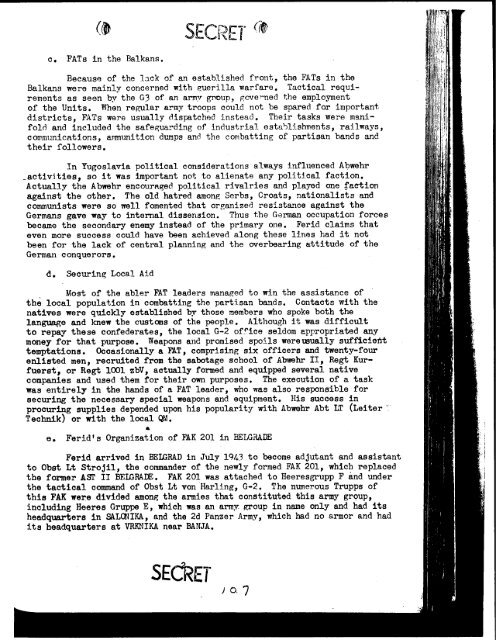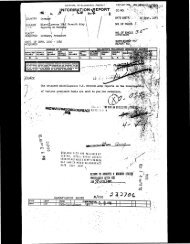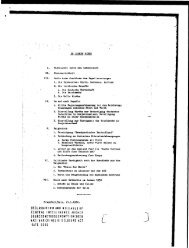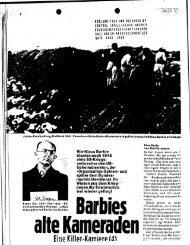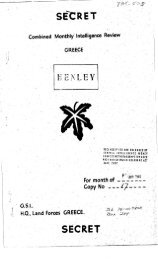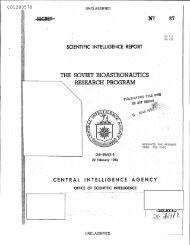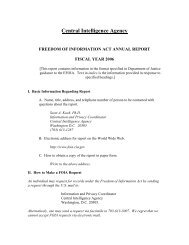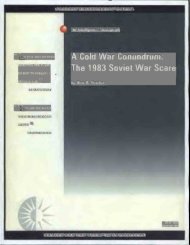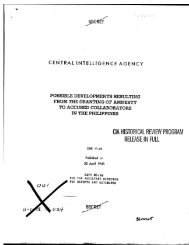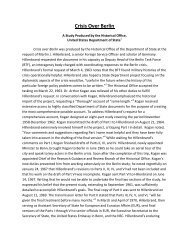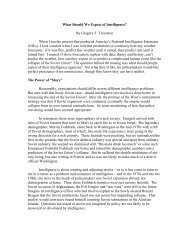RIO 1055 .U51 S-E -C -R--L--T U.S. Army. European Command ...
RIO 1055 .U51 S-E -C -R--L--T U.S. Army. European Command ...
RIO 1055 .U51 S-E -C -R--L--T U.S. Army. European Command ...
Create successful ePaper yourself
Turn your PDF publications into a flip-book with our unique Google optimized e-Paper software.
SECRET (41<br />
c. FATs in the Balkans.<br />
Because of the lack of an established front, the FATs in the<br />
Balkans were mainly concerned with guerilla warfare. Tactical requirements<br />
as seen by the G3 of an army group, gove rned the employment<br />
of the Units. When regular army troo p s could not be spared for important<br />
districts, FATs were usually dispatched instead. Their tasks were manifold<br />
and included the safeguarding of industrial establishments, railways,<br />
communications, ammunition dumps and the combatting of partisan bands and<br />
their followers.<br />
In Yugoslavia political considerations always influenced Abilehr<br />
_activities, so it was important not to alienate any political faction.<br />
Actually the Abwehr encouraged political rivalries and played one faction<br />
against the other. The old hatred among Serbs, Croats, nationalists and<br />
communists were so well fomented that organized resistance against the<br />
Germans gave way to internal dissension. Thus the German occupation forces<br />
became the secondary enemy instead of the primary one. Fend claims that<br />
even more success could have been achieved along these lines had it not<br />
been for the lack of central planning and the overbearing attitude of the<br />
German conquerors.<br />
d. Securing Local Aid<br />
Most of the abler FAT leaders managed to win the assistance of<br />
the local population in combatting the partisan bands. Contacts with the<br />
natives were quickly established by those members who spoke both the<br />
language and knew the customs of the people. Although it was difficult<br />
to repay these confederates, the local G-2 office seldom appropriated any<br />
money for that purpose. Weapons and promised spoils wereueually sufficieht<br />
temptations. Occasionally a FAT, comprising six officers and twenty-four<br />
enlisted men, recruited from the sabotage school of Abmehr II, Regt Kurfuerst,<br />
or Regt 1001 zbV, actually formed and equipped several native<br />
companies and used them for their own purposes. The execution of a task<br />
was entirely in the hands of a FAT leader, who was also responsible for<br />
securing the necessary special weapons and equipment. His success in<br />
procuring supplies depended upon his popularity with Abwehr Abt LT (Leiter<br />
Technik) or with the local QM.<br />
e. Ferid's Organization of FAK 201 in BELGRADE<br />
Fend arrived in BELGRAD in July 1943 to become adjutant and assistant<br />
to Obst Lt Strojil, the commander of the newly formed FAK 201, which replaced<br />
the former ASP II BELGRADE.. FAK 201 was attached to Heeresgrupp F and under<br />
the tactical command of Obst Lt von Harling, G-2. The numerous Trupps of<br />
this FAK were divided among the armies that constituted this army group,<br />
including Heeres Gruppe E, which was an army group in name only and had its<br />
headquarters in SALONIKA, and the 2d Panzer <strong>Army</strong>, which had no armor and had<br />
its headquarters at VRKNIKA near BANJA.<br />
SECRET<br />
0


